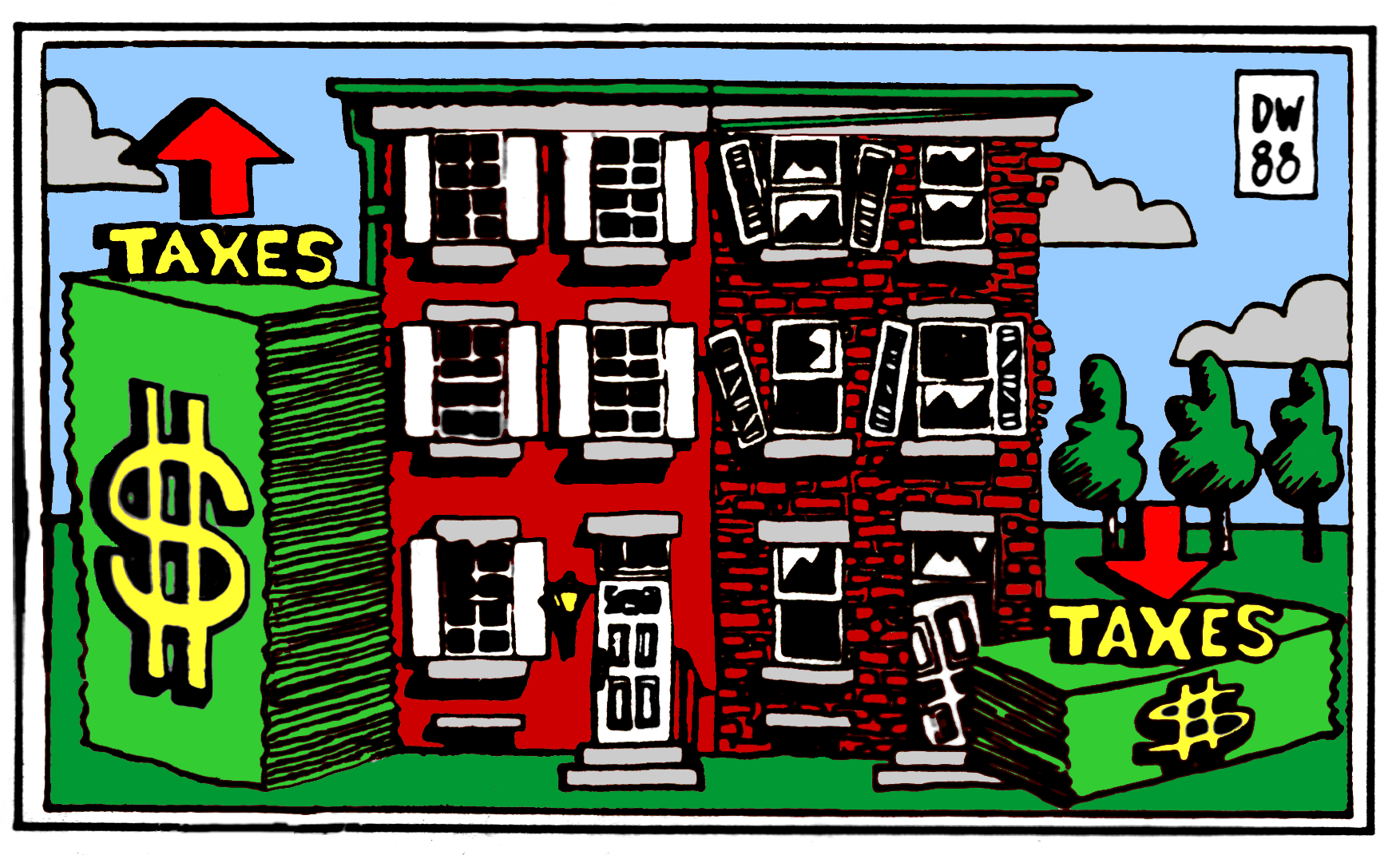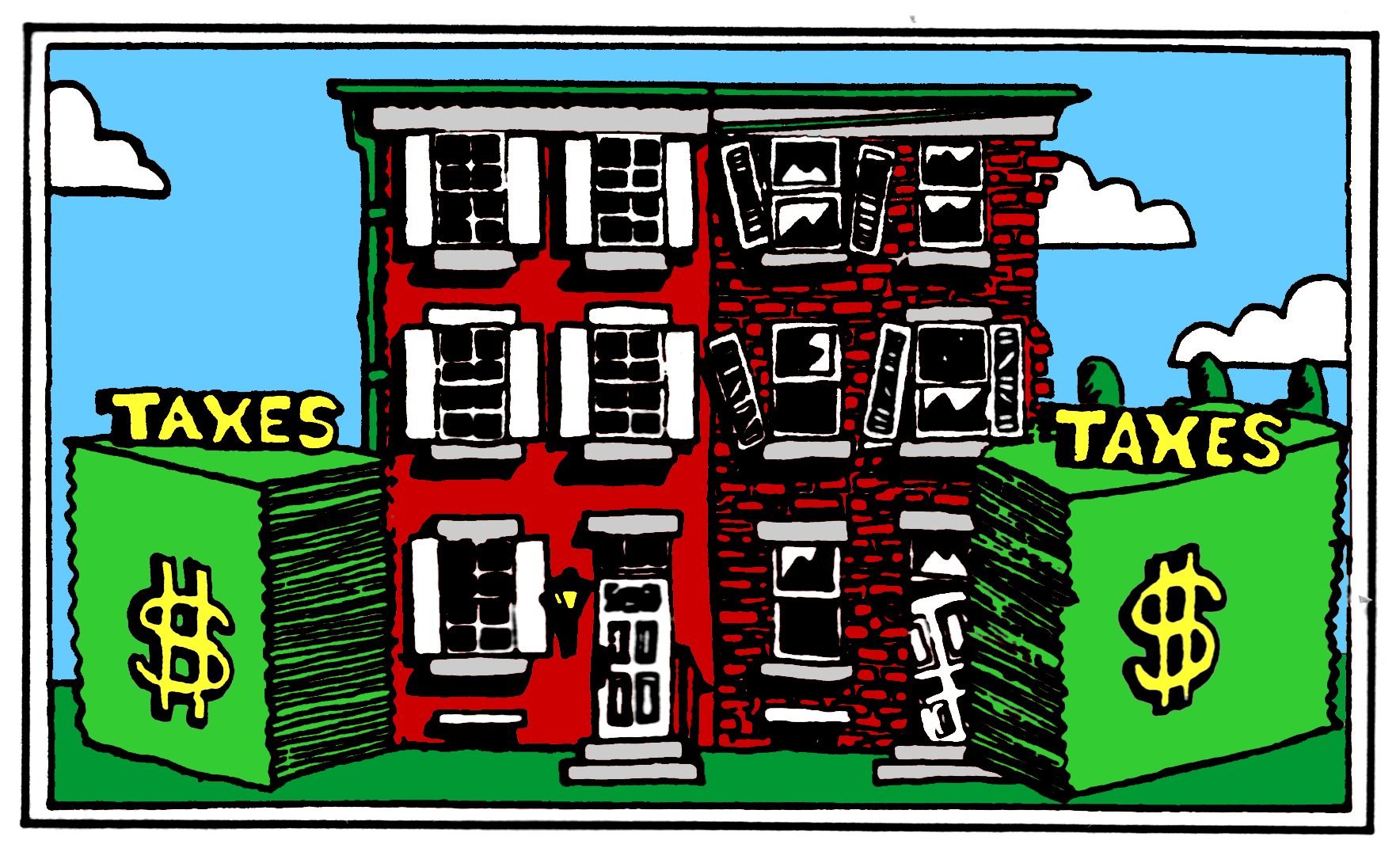 Land Value Tax
Both
ground rents, and the ordinary rent of land, are a species of revenue
which the owner, in many cases, enjoys without any care or attention of
his own. Though a part of this revenue should he taken from him in
order to defray the expenses of the state, no discouragement will
thereby he given to any sort of industry. The annual produce of the
land and labour of the society, the real wealth and revenue of the
great body of the people, might be the same after such a tax as before.
Ground rents, and the ordinary rent of land, are therefore, perhaps,
the species of revenue which can best bear to have a peculiar tax
imposed upon them. - Adam Smith, Wealth of Nations, Book V, Chapter II, "Of the Sources of the General or Public Revenue of the Society" For efficiency, for adequate revenue and for justice, every user of land should be required to make an annual payment to the local government, equal to the current rental value of the land that he or she prevents others from using. - Letter to Mikhail Gorbachev, signed by 30 prominent economists, including four winners of the Nobel Prize in economics. |
Saving Communities
|
||||||
Home |
Site Map |
Index
|
New Pages |
Contacts |
Land Value Tax
Conventional
property tax falls mostly on improvements.
To levy a
conventional property tax, assessors normally determine the
value of the land and the additional value of the improvements. The two
values are added together and the total value is taxed. As a result,
property tax falls mostly on improvements.
As a result, property tax penalizes most home owners, who usually
improve and maintain their homes better than absentee owners. The
property tax on improvements also discourages construction
while it rewards those who milk run-down properties or sit on vacant
properties with light taxes.
Land value tax (LVT) untaxes improvements

Jurisdictions that levy land value taxes charge lower rates (or no tax at all) on improvements. Taxes burdens on well developed and well maintained properties fall and burdens on blighted and vacant properties rise until identical lots pay the same taxes no matter what the improvements on those lots are worth.
LVT is easier to assess
Land lies out of doors, and all features are fully visible. In contrast, assessors have no right to inspect the interior or buildings without the building occupant's consent, and considerably more skill is required to assess the value of structural integrity and amenities. Land can be assessed more accurately then buildings, at a fraction of the cost of assessing buildings.
LVT fosters honesty
Conventional property tax encourages people to hide improvements, sometimes by secretly remodeling without filing building permits. Such dishonesty to avoid an assessment hike can create fire and health hazards, as the main purpose of permits is to insure that safety codes are respected. Other taxes encourage people to conspire to not report, or under-report, income, sales, etc. These corrupting incentives work not merely on taxpayers, but on government itself. Who is to know when a tax collector has "looked the other way" or brokered a deal if the tax information is private? Land values are entirely public information, and the factors that determine land values are also public information.
Location, location, location
Land values vary tremendously according to location. A square yard of prime Manhattan land is worth more than a typical acre of New York State farmland. The value of land in the most affluent residential neighborhoods can easily exceed 100 times the value in the poorest neighborhoods, especially where undertaxation of land has encouraged speculation.
Most home owners pay less
Dozens of studies in dozens of cities have shown that most home owners pay less under land value tax than under property tax, and much less than under income taxes. The only exceptions we have seen are where only a small minority of residents can afford home ownership or where businesses have been so overtaxed that demand for business properties has been discouraged.
LVT encourages growth
Hundreds of taxing jurisdictions around the world have experienced increased construction and renovation after shifting to LVT, including over 20 taxing jurisdictions (mostly cities) in Pennsylvania. Pittsburgh, which had higher taxes on land than on buildings from 1913 to 2000, enjoyed a major "renaissance" after World War II, despite an abrupt reduction in the demand for armor plate, most of which had been produced in Pittsburgh. This renaissance was the subject of articles in at least 27 magazines. Another major surge in construction occurred in the early 1980s after Pittsburgh dramatically increased its tax rates on land value, despite the closing of its largest employer in 1979, Jones & Laughlin Steel. This second surge, dubbed "Renaissance II," was featured in the 1983 Fortune article, "Higher Taxes that Promote Development."
LVT helps small business
Small businesses are more land-effficient, while big businesses are more labor efficient. Shifting to land value tax gives a competitive advantage to neighborhood business districts over shopping malls, small merchants over chain stores, and full-time family farms over agribusiness. By keeping land prices low, it also helps new businesses, which must buy or rent land, compete with established businesses that own their land free and clear.
LVT keeps housing affordable
LVT has such a powerful dampening effect on idle land speculation that even the land portion of the real estate tax keeps housing affordable. Cities with the highest real estate taxes have the most affordable housing. Texas and California were the two fastest growing states in the second half of the 20th century. Texas, which relies heavily on property tax, having no personal income taxes, has four of the six most affordable cities in the nation. California, which dramatically curtailed its property taxes, has 23 of the 25 least affordable cities.
It is only logical that a tax on buildings would discourage construction and reduce the supply of buildings, increasing real estate prices and rents. However, LVT is such a potent disincentive to idle landholding that it has a much stronger opposite effect. We found a strong correlation between high real estate taxes and housing affordability.
LVT reduces foreclosure
Keeping house prices stable and affordable reduces foreclosures. Also, any real estate tax must be born by the bank or mortgage company that forecloses. This makes mortgagors more willing to negotate in order to avoid taking possession of the tax obligations. Beyond that, tax impact studies in Pittsburgh, Clairton, Duquesne and McKeesport have shown that LVT saves mortgaged home owners even more than other home owners.
LVT costs renters nothing
Economists agree that LVT is not passed on to renters, because rents are determined by what the market will bear, not by landlords' costs. LVT benefits landlords by encouraging higher density and attracting more tenants, not by gouging existing tenants. Other taxes drive productive tenants away and depress rents by more than what the landlord would have paid under a land value tax. All taxes eventually come out of rent, and LVT is the only one that does not discourage economic growth.
LVT is naturally progressive
LVT is most burdensome to those who hold valuable urban land they are not using. Clearly, these owners have no cash-flow problems, or else they would sell their unused land to people who would develop it. It also shifts the tax burden from home owners to corporate-owned and absentee-owned property, although corporations and absentee owners who fully develop their properties still save. Because land value tax is not passed on to renters or consumers, and because it keeps housing prices low for home buyers, it is the most progressive of all taxes.
LVT helps keep government local
One of the excuses for centralizing government is that other taxes chase residents and businesses out of local taxing jurisdictions. Because land is the one thing that does not cross borders to escape taxation, it creates no rationale for shifting government to state and federal jurisdictions.
LVT reduces sprawl
The need for government services is naturally highest in urban areas, where land prices are also highest. Higher taxes in cities and inner suburbs drive development outward, and land speculation also causes development to leapfrog over better urban and suburban sites into rural areas.
Replacing taxes that drive people away with a tax that discourages land speculation draws development inward, reducing sprawl. Places that have adopted LVT enjoy not only more development, but more compact development.
LVT streamlines government
Encouraging growth reduces the rationale for economic development subsidies. Growth also creates jobs, reducing the costs of unemployment compensation and public welfare expenditures. Reducing sprawl reduces the need for transportation expenditures. Keeping housing affordable reduces the need for housing subsidies and public housing.
Every proposed public expenditure should increase land values by more than its cost. Governments that fund themselves from a land value tax tend to make more rational spending decisions.
LVT reflects taxpayer benefits
The value of land is the only value that is created by access to community-created and government-created advantages. Under a land value tax, every taxpayer pays in proportion to the benefits he receives, and does not pay on the fruits of his own labors.
LVT is the
most endorsed tax
From the seventeenth century to this day, and from across the political spectrum, LVT has been endorsed by more outstanding icons of economics, philosophy and statesmanship than any other tax.
LVT has a rich and strong history.
LVT was a centerpiece of classical liberalism, the progressive movement and the early labor movement. It was embraced by many of America's founding fathers and written into the Articles of Confederation. The first two tax rebellions in the United States were led in opposition to taxes that shifted the tax burden off of early land monopolists.
LVT is fundamentally fair
Whether the criterion is ability to pay or reflection of benefits received, LVT is the most fundamentally fair broad-based tax available. The biggest obstacle to adopting LVT is that interest groups try to get benefits for themselves at the expense of others. Under LVT, everyone pays in proportion to the benefits they ultimately receive.
Privileged interests oppose LVT
The great difficulty in advancing LVT is that it shifts the tax burden onto those who not only have the most ability to pay, but have the most ability to influence political leadership and public opinion. Yet LVT has often been supported by wealthy people who put public interest ahead of their personal enrichment.
LVT is gaining momentum
The economic successes in cities that have adopted LVT, and the economic consequences of productivity taxation, have led more and more cities to embrace LVT in Pennsylvania, where it is already permitted, and has led other states to consider it as well. It also enjoys increased support in several other countries.
Saving Communities
631 Melwood Avenue
Pittsburgh, PA 15213
United States
412.OUR.LAND
412.687.5263